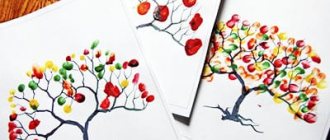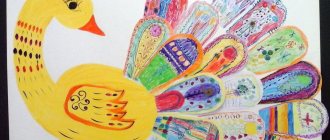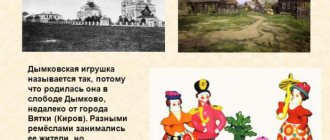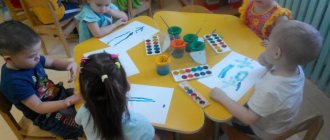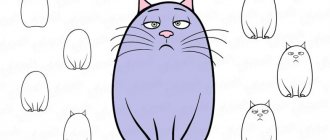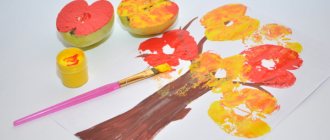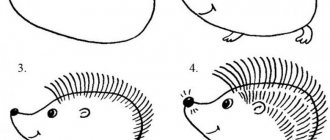Preview:
Department of General Education
of the Rtishchevsky District of the Saratov Region
Municipal preschool educational institution "Kindergarten No. 12 "Zvezdochka". G. Rtishchevo, Saratov region"
Topic: “Bread is the head of everything”
Educator: Kolomiets V.E.
Abstract drawing “Bread is the head of everything”
Goal: To teach children unconventional ways of drawing an ear of wheat.
expand and deepen children’s knowledge about a wheat ear and its appearance.
strengthen your drawing skills using brush bristles.
— increase the motivation of visual activity through awareness of its moral significance; improve gross and fine motor skills.
activate adjectives in children’s speech (yellow, prickly, golden).
Educational objectives: to cultivate independence and focus in work, the ability to complete a job started, accuracy when working with paints. Cultivate a caring attitude towards bread.
The teacher tells the ancient legend about the ear of bread:
— In ancient times, when God himself walked the earth, people’s lives were easy and well-fed. It was summer all year round. When needed, it rained, when needed, the sun shone. Fruit trees grew in the forests. The animals were docile, and all fed on grass. People knew no disease, no troubles, no hunger. The ear of grain was very large - there was almost no stalk, the grains started from the ground itself, and each grain was the size of a bean. There was so much bread that no one valued it. One day God walked the earth and saw how a mother wiped a soiled child with the edge of freshly baked bread and at the same time refused food to the wanderer. God got angry, ascended to heaven and deprived people of bread. The earth became like stone, the rivers dried up, the grass withered. Hunger has set in. Then the cat and dog went to God to ask for bread. He took pity and allocated a small ear on a long stem for the cat and dog's share. God made it so that summer began to occupy only half of the year. Winter is for people, and summer is for animals. When people baked fresh bread, they gave the first piece to cats and dogs. Now tell me, what does the legend teach?
Educator: guys, guess the riddle, “a house grew up in a field, the house is full of grain” (ear of grain). Here is the spikelet as our guest today, let’s tell you what we know about it. Where does the spikelet grow? What plants still grow in the field that have spikelets?
Children: wheat, rye, barley.
Educator: guys, let's look at the picture showing a wheat field. What's on the spikelet?
Children: grains (the teacher demonstrates a natural ear of wheat)
A grain has fallen into the ground (children crouch),
It began to germinate in the sun (arms above head).
The rain watered the ground, and the sprout grew (the children get up slowly).
He was drawn to the light and warmth, and turned into a handsome man.
Educator: children, let's sit down at the table and try to draw a wheat field (first we draw a stalk, and then blot the bristles of the brush.
The teacher asks the children to imagine that he is a spikelet, and they are grains. Children slowly gather in a circle on the carpet, with the teacher in the center.
— Guys, tell me what is made from wheat grains? (different types of flour)
-What are they made from flour? (bakery products)
- Today our spikelet has prepared bread for you.
- When you eat, remember the legend of the ear of bread.
Source
Drawing lesson for children of the senior group “Bread is the head of everything!”
Svetlana Sheypak
Drawing lesson for children of the senior group “Bread is the head of everything!”
Dear Guys! Imagine that we went to a bakery. What a wonderful smell of fresh bread ! On the shelves, loaves, buns, loaves, pies, bagels and puff pastries are neatly laid out in rows. And all this is baked from white wheat flour.
Perhaps there is nothing better than soft wheat bread ! What does wheat look like? It has a dense, hollow stem that holds an ear full of grain. Ripe wheat grains are oblong, yellowish-golden in color, surrounded by a fairly hard shell that protects them from drying out.
Wheat, which is now grown in grain fields , comes in two types: hard and soft. Pasta and vermicelli are made from solids. It is not suitable for baking because it contains little gluten, a substance that gives bread looseness and porosity. Bread is baked from soft wheat, which contains a lot of gluten. In summer, the wheat ear fills with golden ripeness and becomes large and heavy.
Project. Bread is the head of everything! | Country of Masters
Good day to all! Last year, my son (a second grader at the time) did (with my help) a project on the theme “Bread is the head of everything.” The project was made in PowerPoint; when exported to another format, the quality of the slides deteriorated. For the project and for the way his son defended it, Dima received a finalist certificate (the project was one of the best in the school, there were no winners this time). The presentation of the project required about 12 - 15 slides (preferably without text), the speech should take about 10-15 minutes. In this regard, the text was created according to the principle - short and clear. And there is no text on the slides, so each slide will accompany the speech that Dima spoke at his defense.
Slide 2 Purpose: to get acquainted with the process of growing bread; talk about the value of bread and respect for it and the people who raised it. Bread is a symbol of well-being and prosperity.
Bread on the table is wealth in the house.
Slide 3 Bread provides our body with proteins, carbohydrates, and beneficial microelements, which are necessary for brain function. Bread contains vitamin B, which strengthens the nervous system, memory, and improves digestion. Bread crust helps our body resist many cancers. Medical scientists believe that an adult should eat 300-500g of bread per day, or 700g during hard work. Children and teenagers need 150-400g of bread. A person gets almost half of his energy from bread.
Slide 4 Scientists believe that bread is over 15 thousand years old. True, bread in those ancient times was not much like today. The first bread was a liquid pulp made from cereals and water. In ancient Egypt, 5-6 thousand years ago, there was a kind of rebirth of bread. There they learned how to loosen dough using the fermentation method.
In medieval England, wealthy people used black bread as plates: large loaves of bread were cut into large slices, and a small depression was made in the middle of the piece into which food was placed. After lunch, these “plates” were collected in a basket and distributed to the poor.
Slide 5 You can’t get rye bread, loaves, rolls while walking. People cherish bread in the fields, they spare no effort for bread. (approx. author of poems Y. Akim) Bread appears on our table thanks to the hard work of grain growers. Strong machines help people grow and harvest bread. In the spring, tractors go out into the field. A plow is attached to the tractor, the plow turns over the earth. It comes out in large, dense clumps. Then the tractor pulls a harrow, similar to a large rake, which loosens the ground. Then seeders go out onto the plowed field and sow in three rows at once.
Slide 6 Spikelets grow from grains. Each ear contains many new grains. The grain fields are like the sea. The wind blows and the ears of corn sway like waves. The ears are golden, it's time to harvest. You must not hesitate so that the grains do not fall to the ground. Harvesters are out in the field, cutting the ears, threshing them, shaking out the grains from the ears.
Slide 7 Machines deliver grain to a mechanized conveyor for cleaning and drying. Then the grain is taken to the elevator - this is a large granary. Here the grain is ground - ground and flour is obtained. From a grain of wheat you can get about 20 milligrams of first grade flour. Baking one loaf requires more than 10 thousand grains.
Slide 8 Flour is supplied to bakeries and bakeries. Here they make bakery and confectionery products from it, which we then buy in stores. This is the long and difficult path that bread takes from the field to our table.
Slide 9 Today, the names of types of bread and bakery products number in the hundreds. (approx. list of names, for example, some names are shown on the slide)
Slide 10 Our main breadwinners are wheat and rye. White bread, rolls, cookies, and bagels are made from wheat flour. And they also make semolina from wheat. Black bread made from rye flour. The ear of wheat is thicker, and the ear of rye is thinner. Wheat grains are rounder, and rye grains are longer.
Slide 11 I decided to germinate wheat grains at home and kept a calendar of observations. Here are my observations. (note: all observations were photographed and signed, when and what happened to the sprouts, Dima commented on all this during his defense)
Slide 12 It was not possible to grow ears of corn at home, but I watched the ears of rye and oats, which we planted and raised with my grandparents, grow in the summer. And we planted them in the fall before winter. Our photographs show how the spikelets changed at different times. My mother and I also made a visual aid with the stages of the birth of bread.
Here I will step back a little from the project itself and demonstrate the very visual aid mentioned above. From the grains ears grow, from the ears we get grain, from the grain we get flour, and from the flour we make baked goods.
Wheat grains, ears, flour - real, baked goods made from salt dough, dried, painted, varnished.
Everything was arranged in the form of a stand.
Stand size.
Closer.
Many said that it turned out natural.
Let's continue.
Slide 13 Today you can buy as much bread as you want in the store, but there was a time when a piece of rye bread was more valuable than gold. During the Great Patriotic War, bread was baked from husks, grass, quinoa, bran, and sawdust. And they gave us a small piece of this bread, 125g, for the whole day. People understood that bread was their life. This piece could hardly be called bread, because it contained only 5 grams of flour, the rest was impurities. The Museum of the History of Leningrad contains a piece of moldy bread the size of a little finger. This was the daily ration for the residents of the city besieged by the Germans; there were no other products. While working on the project, I found wonderful poems: A boy who kicks bread with his foot, A boy who knows no hungry years, Remember that there were dashing years. Bread is life, not just food. They swore by bread, They died for bread, Not so that they could play football. Folk wisdom is hidden in the word. This is what our people say: “If you don’t value bread, you’ve ceased to be a human being.” (approx. author of poems Bobo Hoxha)
Slide 13 In Russia, according to a long-standing custom, dear guests are greeted with bread and salt. There are also a number of signs; it is believed that people who break bread become friends for life. It was considered the greatest sin in Rus' to drop at least one crumb of bread, and an even greater sin was to trample this crumb underfoot. (note: there is a speaker icon on the slide - to this slide we added an excerpt from the song (chorus) by Olga Voronets “Bread is the head of everything”, namely these lines: You remember, son, the golden words - Bread is the head of everything, Bread is the head of everything! ) Take care of the BREAD! BREAD is our wealth! Thank you for your attention!
stranamasterov.ru
Preview:
Goal: to cultivate a caring attitude towards bread.
Objectives: to remind that bread is everyday
product; continue to learn to think about the content of your future drawing; develop the skill of drawing the outline of an object with a simple pencil with light pressure on it; consolidate the ability to paint over an image; develop imagination and independence.
Materials and equipment: illustrations and drawings on the topic “Bread”,
ears of rye, bakery products, flour, white sheets, simple pencils,
wax crayons, musical accompaniment.
1. Organizational moment.
- Guys, I’ll tell you a riddle now, and you guess it and find out what
Today we will draw.
Everyone calls him the head,
Never throw it on the floor.
In the oven he grew up and became stronger,
This is our favorite...(bread)
- Right. We will draw bread today. (Conversation with children). Let's
Let's look and touch our baked goods (examination). Pay attention to the shape, size, color.
The seed is growing (They squat, clasping their knees with their hands)
The seed is growing - (Squatting, hands pulled up)
Reached for the sun. (Stand up, stretch on tiptoes, hands up)
It plays with the breeze, (Hands up, swaying gently from side to side
The breeze shakes it
He presses low to the ground (Tilting towards his toes) - that’s how fun he plays!
(Straightened up, jumped, hands up).
Invite the children to put sheets of paper in front of them, take simple
pencils, specify that the drawing will be located
all over the sheet of paper.
- Guys, tell me, how will we draw with a simple pencil?
(Answers). Right. To begin with, we will draw an outline using a pencil
You need to press lightly.
When the main details of the drawing have been drawn, offer the children
take wax crayons and color.
4. Make an exhibition for parents.
5. Put workspaces in order.
Summary of a lesson in fine art in the preparatory group “Bread, bakery products”
Elena Papenkina
Summary of a lesson in fine art in the preparatory group “Bread, bakery products”
Summary of a lesson in fine arts in the preparatory group “ Bread , bakery products ”
1. Teach children to think about the content of their work based on personal experience.
2. Clarify and consolidate children’s knowledge about bakery products .
3. Develop the ability to convey the shape of familiar objects, their proportions, using previously learned modeling techniques.
Material and equipment: Images and illustrations on the topic “ Bread ”
, models
of bakery products , salted dough, oilcloths, stacks, “Magic wand”
.
Preliminary work: reading Prishvin’s “Fox Bread ”
, Musatov A. - How
bread came to the table , G. Lagzdynia “The Adventures of
the Bread Man ” , S. Shurtakov
“The grain fell into the ground”
, Belarusian folk tale
“Light
Bread ” .
Learning sayings about bread , looking bakery products in a bread store (excursion to a bread store , reading poems by D. Kugultinov “A Piece of
Bread ” , H. Mänd
“
Bread ” , K. Kubilinskas
“Sheaves”
, the story by E. Shim
“
Bread Grows ” .
1. Organizational moment.
Little Red Riding Hood comes to visit the children, she explains to the children that she forgot the pies that her mother baked, and which she should take to her grandmother, somewhere in the forest when she was picking flowers.
The teacher calms Little Red Riding Hood and invites the children to help Little Red Riding Hood bake a treat for grandma.
— Guys, let's help Little Red Riding Hood?
But first I want to play a game with you called “Magic Wand”
.(the wand is passed around in a circle, the child holding the magic wand names
the baked goods .)
Educator: Well done guys, you know so much about baked goods , please tell me, what do baked goods ? Where does flour come from? What grain crops do you know? (wheat, rye, barley, oats, and who bakes bread ? (bakers)
On the topic: methodological developments, presentations and notes
Summary of a lesson in the senior group on the topic Bread is the head of everything.
I offer you a summary of open direct educational activities for children of the senior group on the topic: “Bread is the head of everything.” This material is useful for teachers of the senior group. Cognitive
let children understand that bread is a daily food product, introduce children to the variety of bakery products, consolidate knowledge about the long journey of bread from field to table, and educate uva.
Give children an idea that bread is a daily food product; introduce children to a variety of bakery products; consolidate knowledge about the long journey of bread from field to table; V.
Give children the idea that bread is a daily product. Tell where bread comes from, how it is made, who grows it and bakes it. To instill respect for the work of adults and respect for bread.
Source
Summary of a drawing lesson Topic: “Glory to the bread on the table”
Suitable for both adults and children
Drawing lesson notes
Topic: “Glory to the bread on the table”
(with children of the preparatory group)
Purpose:
continue to learn to think about the content of your future drawing; cultivate a caring attitude towards bread.
develop the skill of drawing the outline of an object with a simple pencil with light pressure on it; consolidate the ability to paint over an image (without going beyond the outline, evenly, without gaps, applying strokes in
continue to learn to think about the content of your future drawing;
develop imagination and independence;
cultivate a caring attitude towards bread;
learn to finish what you start.
Materials and equipment:
illustrations and drawings on the theme “Bread”, ears of rye, bakery products, white sheets, simple pencils, sets of colored pencils, musical accompaniment: music to relieve stress).
Educator:
Guys, I’ll tell you a riddle now, and you guess it and find out what we’ll be drawing today.
Guess easily and quickly: soft, fluffy and fragrant,
It’s black, it’s white, and sometimes it’s burnt.” (Bread)
Educator:
Right. We will draw bread today.
Look, on our plate there is a variety of bread made from rye, wheat, and oats. Let's look and touch our baked goods (examination). Pay attention to the shape, color, size.
Let's remember how bread came to our table.
Bread made from wheat is called what?
Rye flour bread? Made from oatmeal? (children's answers).
Now let’s remember once again how bread is grown and baked:
In the spring, who plows the field first? (grain growers).
Sowing with what? (wheat, rye.)
What grows from grain? (ears containing many new grains).
When is the harvest harvested? (autumn)
Who goes out into the field to collect? (combiners)
Who removes grain from the fields? (car, driver).
Where is grain sent for storage? (elevator)
Who can tell me where flour is made? (at the mill).
Where is the bread baked? (bakery).
Then the bread appears where? (shops, hospitals, kindergartens.)
The seed is growing (They squat, clasping their knees with their hands)
A seed is growing (They are squatting, arms pulled up)
Reached for the sun. (Stand up, stretch on tiptoes, hands up)
It plays with the wind, (Hands up, swaying quietly from side to side)
The breeze shakes it
Presses low to the ground (Tilt towards toes)
- that's how fun it is to play! (Straightened up, jumped, hands up).
1. Invite the children to put sheets of paper in front of them, take simple pencils,
clarify that the sheet is large and the drawing will be located across the entire sheet of paper.
- Guys, tell me, how will we draw with a simple pencil? (Answers).
Right. To begin with, we will draw an outline; you need to press the pencil lightly so that
our drawing lines were barely noticeable; there was no need to paint over them. (Musical accompaniment: music to relieve stress).
When the main details of the drawing have been drawn, invite the children to take colored
pencils and color. Remember that strokes must be applied in one direction, without going beyond the contour, evenly, without gaps. Encourage the use of different colors, clarify that different shades of color can be achieved by using different pressure
Enjoy beautiful drawings with your children. Make an exhibition for parents. Tidy up your workspaces.
- What did we draw today?
— What did you like most?
Material number: DB-1241547
Didn't find what you were looking for?
You might be interested in these courses:
How to draw bread | Just crafts
Bread has been an integral food product since ancient times. Therefore, you can often hear the expression that he is the head of everything. Not a single dinner or feast is complete without it.
So let's learn how to draw bread in the form of a peasant loaf with sesame seeds, which will lie on a cloth or towel. To give a natural natural shade, we use brown and yellow pencils, which we apply directly to the entire product.
Materials for drawing bread:
- paper;
- black and colored pencils;
- liner (thin black gel pen).
Drawing bread in stages:
Bread can have different shapes. Let's depict it in the form of a loaf, which will have beautiful tubercles with cuts. First, let's draw an oval, which will become an outline.
Then we form the top part of the bread, which has a delicious top crust. To do this, draw three tubercles. From them we draw stripes in the center.
Then we remove the auxiliary lines of the bread contour with an eraser and draw fabric around it (optional). We will depict it using lines and arcs to show the folds.
Finally, add small sesame seeds to the top of the bread.
Now we use yellow and light brown pencils to apply the base shade on the food product.
For a beautiful and appetizing color of crispy crust on bread, you should use darker brown shades. We apply them both to the bottom of the object and to the top. We work on the depressions between the tubercles with dark shades to get a shadow in these places.
Use a blue pencil to color the fabric. For a more saturated color in shadow areas, use a purple tint.
We darken the entire drawing with a black pencil to get a shadow in certain places.
We also work out the drawing with a liner with a black rod for the outline. Also, let's not forget about the small grains on the top of the bread, which should also be drawn.
What came out was this appetizing drawing of bread on a bluish fabric, which was achieved thanks to step-by-step drawing and the necessary materials. In the finished illustration you can add ears of wheat, a towel and a wooden table.
prostopodelki.ru
Leave your comment
Responsibility for resolving any controversial issues regarding the materials themselves and their contents is taken by the users who posted the material on the site. However, the site administration is ready to provide all possible support in resolving any issues related to the work and content of the site. If you notice that materials are being used illegally on this site, please notify the site administration using the feedback form.
All materials posted on the site were created by the authors of the site or posted by users of the site and are presented on the site for informational purposes only. Copyrights for materials belong to their legal authors. Partial or complete copying of site materials without written permission from the site administration is prohibited! The opinion of the administration may not coincide with the point of view of the authors.
Source

